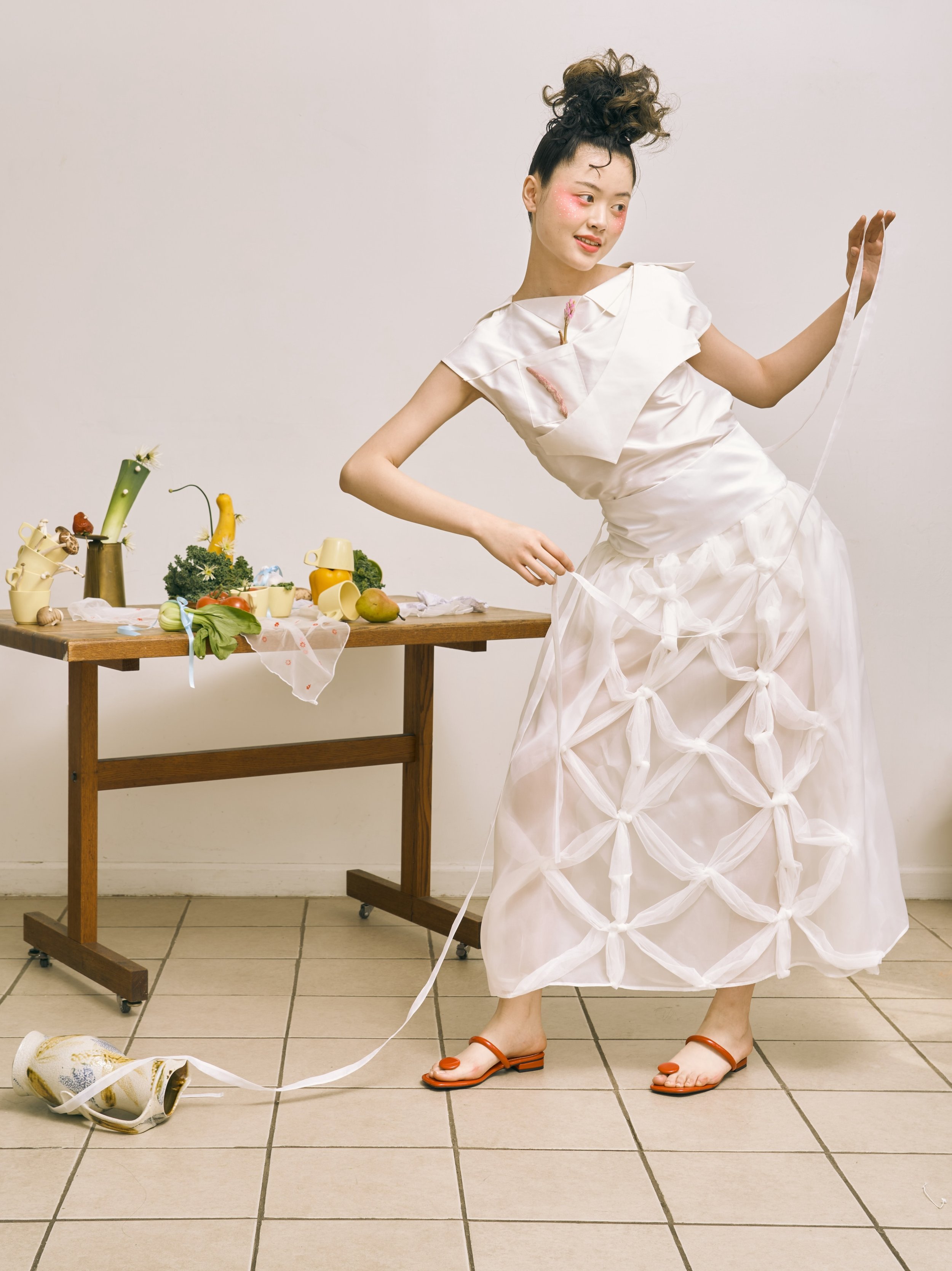Interview
Yixuan Nie
Yixuan Nie is a multidisciplinary artist and fashion designer based in New York, originally from Beijing. Her work explores memory, material, and cultural identity through sculptural garments and sustainable design. Influenced by the visual language of Beijing’s hutongs and the textures of everyday life, she combines secondhand clothing, hand-drawn illustrations, and photography to build poetic narratives about transformation and time. A graduate of the Fashion Institute of Technology, her collections have been featured in Vogue, Marie Claire, Selin, and 1Granary, and selected for exhibitions in both New York and Shanghai. Her recent projects - including “Grafting Temporal Memory” and “YANXIA” - investigate the emotional weight of reuse, disappearance, and quiet resistance.
What is your background and how did you start your journey in the art world?
“I’m a fashion designer and multidisciplinary artist based in New York, originally from Beijing. I began my creative journey observing the textures of everyday life in the hutongs - Beijing’s narrow alleyways - where peeling walls, worn furniture, and reused objects told stories of time and memory. After studying at the Fashion Institute of Technology, my practice grew to incorporate sustainable fashion, photography, and storytelling. Fashion, for me, became a way to preserve overlooked beauty and critique systems of overproduction.”
What does your work aim to say? Does it comment on any current social or political issues?
“My work aims to reveal the emotional weight embedded in materials and to explore the politics of visibility - whose stories are preserved, and whose are erased. In recent years, I’ve focused on sustainability not just as an environmental issue, but as a cultural one. Through reworking discarded garments, I examine cycles of consumption and labor, and how memory, identity, and intimacy can emerge from what society deems as waste. I see fashion as a poetic form of resistance.”
Do you plan your work in advance, or is it improvisation?
“I begin with a research-based concept - usually a memory, a social tension, or a fragment from everyday life. But I leave room for improvisation, especially when working with reclaimed garments. The material often carries its own history - stains, frays, or wear - which I respond to intuitively. Each decision in cut or reconstruction becomes a dialogue between past and present, form and memory.”
“I’m drawn to interdisciplinary work that blends textile, photography, and documentary processes.”
Are there any art world trends you are following?
“I'm interested in the intersections between craft, memory, and slow fashion - especially how designers and artists are embracing mending, deconstruction, and the imperfections of aging materials. I also follow sustainability-driven practices that challenge linear production systems and redefine luxury through ethical storytelling. I’m drawn to interdisciplinary work that blends textile, photography, and documentary processes.”
What process, materials and techniques do you use to create your artwork?
“My recent series, ‘Grafting Temporal Memory’ and ‘Yan Zia 2.0’ were built entirely from secondhand clothing. I use deconstruction techniques, hand-stitching, natural dyeing, and layering to create sculptural silhouettes that feel archival yet personal. I also photograph my garments in environments - such as alleyways, abandoned spaces, or with daily objects - that echo the emotional weight of the materials. This creates a full-circle narrative between fashion, space, and memory.”
What does your art mean to you?
“My art is a form of preservation and resistance. It allows me to hold onto disappearing textures - both physical and emotional - and reframe them into something new. In a world of speed and consumption, I want to slow down and listen to what used objects and overlooked moments still have to say. In my ongoing project ‘YANXIA,’ for example, I document and reimagine the poetic rhythm of Beijing’s disappearing alley life - retired men playing chess in the summer, corner flower pots next to mismatched furniture, or makeshift barbers on the street. Through both garment design and visual storytelling, I aim to give voice to quiet realities that often go unseen.”
What’s your favourite artwork and why?
“One artist whose work continues to inspire me is Vivian Maier, the American street photographer whose vast archive was discovered posthumously. Her images of ordinary people - taken on sidewalks, at markets, or in moments of quiet solitude - are full of subtle drama, empathy, and honesty. I deeply relate to her ability to find meaning in the overlooked. Although I come from a fashion design background, her work reminds me that observation is the beginning of all creation. Her photography has deeply influenced the way I approach both garment-making and storytelling. I see fashion not in isolation, but as a dialogue with the lives, bodies, and moments that surround it.”
Have you had any noteworthy exhibitions you'd like to share?
“Yes, I’ve had the opportunity to present my work through a number of notable showcases and features that reflect my ongoing exploration of sustainability, cultural memory, and urban storytelling. My project ‘YANXIA,’ an ongoing series that reimagines Beijing hutong life through fashion and visual storytelling, was featured in Vogue’s Spring 2025 trend report and also published in Selin Magazine. The series has been shortlisted for the 2025 Redress Design Award, and is currently in development for future exhibition proposals. My sustainable fashion project ‘Grafting Temporal Memory’ was included in Marie Claire’s ‘Fashion Our Future’ feature, which highlighted emerging designers working with recycled garments. This project was also selected as a semi-finalist in the 2025 Redress Design Award. My earlier collection ‘Hidden Truth,’ which investigates power and sacrifice through sculptural fashion forms, has been featured in independent art and fashion publications including MOB Journal, 17:23 Magazine, and Artells Magazine. The series was also presented at the ‘Reconstruction’ fashion showcase in 2025 at Suhe Haus Art Museum in Shanghai. Each of these presentations allowed me to articulate different dimensions of my practice - from sustainability and urban identity to structural storytelling - and to connect with audiences across both fashion and interdisciplinary art spaces.”
Instagram: @lea_yixuannie
Brush Bio: www.brush.bio/yixuannie




